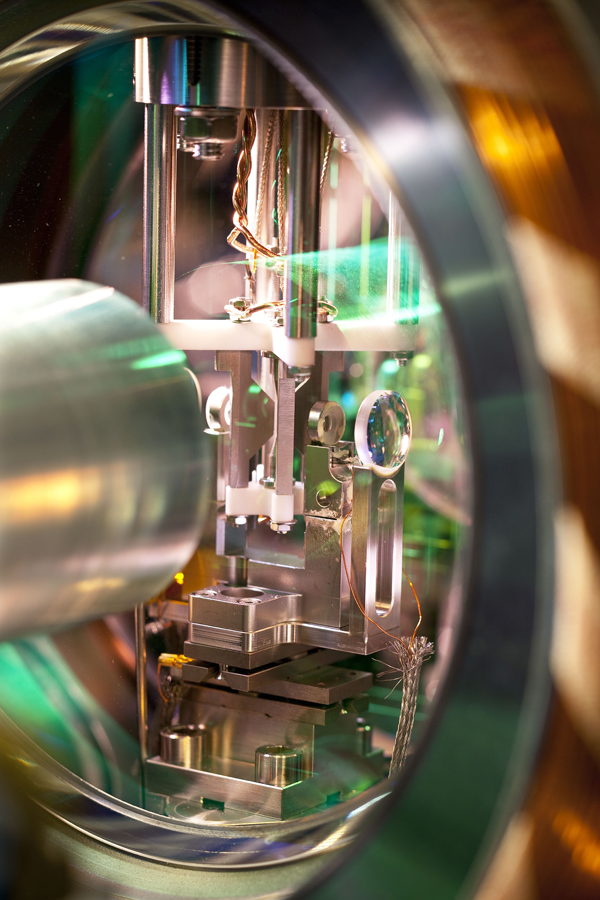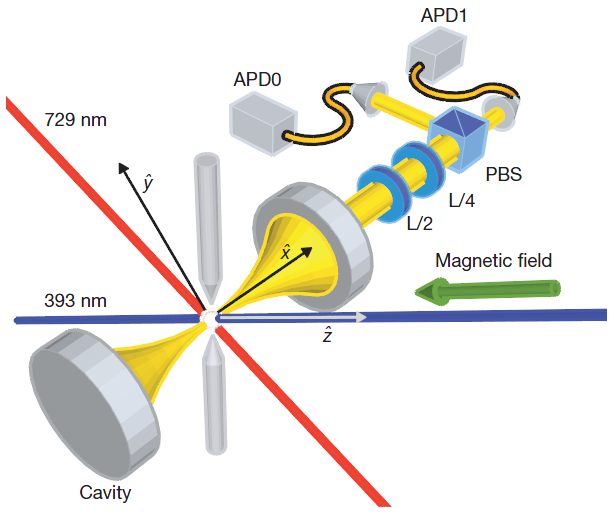Efficient, tunable ion-photon entanglement interface enables quantum networks
May 23, 2012

At the core of the experiment lies an optical resonator consisting of two highly reflective mirrors (credit: C. Lackner/University of Innsbruck)
University of Innsbruck physicists have constructed an interface for quantum networks — the first interface between a single ion and a single photon that is both efficient and freely tunable.
Future quantum computers may be many times more powerful than today’s most powerful supercomputers, but to enable quantum computers at distant locations to communicate with one another, they have to be linked together in a network, which requires a reliable interface between quantum processors and optical information channels.
In contrast to classical information, quantum information can’t be copied without being corrupted (per the no-cloning theorem). Instead, physicists are searching for ways to transfer quantum information between matter and light using entanglement, the quantum property in which the state of one particle depends on the state of a second.
How the tunable interface works
Now, a research team led by Rainer Blatt, Tracy Northup, and Andreas Stute at the University of Innsbruck’s Institute for Experimental Physics has developed an experimental apparatus that traps a single calcium ion in a Paul trap and places it between two highly reflective mirrors. The ion is excited with a laser, thereby generating a photon that is entangled with the ion and reflected back and forth between the mirrors.
Custom tuning of the entanglement between ion and photon is possible by adjusting the frequency and amplitude of the laser.
This technique has two significant advantages over previous approaches that have entangled atoms with light: the efficiency with which we produce entangled photons is quite high and in principle could be increased to over 99 percent,” explains Northup, “but above all, what this setup lets us do is generate any possible entangled state.”

Experimental apparatus and entanglement sequence: An ion is confined in a Paul trap (indicated by two endcaps) at the point of maximum coupling to a high-finesse cavity. A 393-nm laser (blue) generates atom–photon entanglement, characterized using a 729-nm laser (red-brown). The polarization of photons leaving the cavity is analyzed using half- and quarter-waveplates (L/2, L/4), a polarizing beamsplitter cube (PBS), and fiber-coupled avalanche photodiodes (APD0, APD1). (Credit: A. Stute et al./University of Innsbruck/Nature)
To this end, the frequency and amplitude of the laser light are carefully chosen so that the target collective state of the ion and photon is reached. At the core of the experiment lies an optical resonator consisting of two highly reflective mirrors. Photons bounce back and forth up to 25,000 times between these mirrors, interacting with the ion, before escaping through one mirror into an optical fiber.
“Along with an efficient entanglement process, we’ve demonstrated an entangled quantum state between an atom and a photon with the highest precision measured to date,” says Stute.
The experiment offers important insights into the interaction of light and matter and may prove useful in constructing quantum computers or a future quantum Internet. “Whenever we have to transfer quantum information from processing sites to communication channels, and vice versa, we’re going to need an interface between light and matter,” explains Northup.
The researchers are supported by the Austrian Science Fund and the European Union.
Ref.: A. Stute, B. Casabone, P. Schindler, T. Monz, P. O. Schmidt, B. Brandstätter, T. E. Northup, R. Blatt, Tunable Ion-Photon Entanglement in an Optical Cavity, Nature, 2012, DOI: 10.1038/nature11120